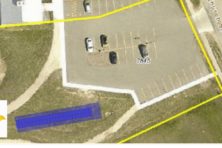Solar Power
- Share
- Tweet
- Pin
- Share

Eighty solar panels were installed on the roof of the riding barn on Rick and Joan Gordon’s property.
Rick Gordon and I set several times to meet at his farm on Little Marsh Road to see the 80-panel solar system that went online Sept. 28, because, according to Gordon, it is the largest solar array in Door County.
But we had one gray and rainy day after another, and we agreed that one day the sun would return, and on that day, I would travel to his farm and talk solar.
Finally, the sun returned on Monday, Oct. 6.
By 1 pm on that first sunny day we had seen in almost a week, Gordon said his solar system “was doing a little more than 16 kW. Max is only about four kW more.”
Gordon admits to being a green, animal-loving vegetarian, but he also worked for years in industrial electronics and is known as the guy who first connected Northern Door to the Internet. We’re not talking about a weekend dabbler here. This guy is a technocrat, in the best sense of that word, a word I think everyone would agree sounds much nicer than nerd or geek.
“I want people to see it. I think they should know about this,” Gordon said of his solar array as we walked the beautiful rolling grounds of the two-siloed farm he and his wife Joan have called home for the past decade, down to the barn that has been converted into a five-star horse condo and meticulously maintained riding arena.
The solar array is inconspicuously anchored to the roof of the riding arena. Unless you know they are there, you would not know 80 solar panels are there.
The roof has a 30-degree pitch, so that is what the panels have. The ultimate panel pitch is 45 degrees, but Gordon knows the 15-degree difference results in an acceptable three percent loss in efficiency.
Being a technocrat, Gordon did his homework before jumping in. In fact, he and Joan first considered wind.
“We looked at wind first,” Gordon said, “but we don’t like killing birds and things like that.”
OK, that’s the bearded hippie Rick Gordon speaking. Here’s the technocrat Rick Gordon with a practical reason for choosing solar: “The wind generators don’t have self-feathering props [feathering reduces drag] so they can’t run when the wind gets too high, and we get a lot of wind here. But you can add wind to this. Wind parallels right into it.”
Of course he “did a fair amount of research” by talking to people all over the country about solar systems.
“I finally decided on some guys in Green Bay because I felt real comfortable with them. The guy I got hold of, I could tell within two minutes he knew what the hell he was talking about,” Gordon said.
That guy was Jesse Michalski, project manager at Eland Electric Corp. of Green Bay and a North American Board of Certified Energy Practitioners licensed solar installer.
“That is not typical for the average residence,” Michalski said of Gordon’s 80 solar panels. “Rick’s got bigger than average usage there with the barns and horse riding arena and all the components.
He’s an above average user of energy. The average home would need about half that size system or a bit less than half.”
The solar panels are from SolarWorld of Hillsboro, Ore. Every component is American made, Michalski said. It’s the only solar panels Eland Electric sells to its customers because, Michalski said, they are American made and the company has been making solar panels for 38 years, so they know what they are doing. He confidently tells customers the solar modules will last 25 years, but suspects they are built to last 30 to 35 years.
The Gordons went into this with the idea of capturing as much solar energy and converting it into usable electricity “as we could get and be legal,” Rick Gordon said. “WPS (Wisconsin Public Service) will allow you to put up 20 kW worth. After that you’re considered a wholesaler and then you’re screwed.”
The total cost was $72,000, but with incentives, Gordon said he only paid $30,000.
“I got a grant and I didn’t have to do anything,” Gordon said.
“We wrote all the grants. Just needed a couple of signatures from Rick,” Michalski. “I do everything I can to take care of my customers. For some it can be a very scary process.”
“Plus,” Gordon said, “we got to write off 30 percent right off the top of our taxes this year.”
And the payoff for running solar panels?
“Spring and fall we’ll probably break about even. Winter we’re not going to generate as much as we use, and in summer we’ll generate way more than we use,” Gordon said. “I punched in some averages. If the average predictions come out right, we’re going to probably come pretty close to breaking even for the year, which means we will probably pay for this somewhere between eight and 10 years.”
For more information on solar power, visit elandelectric.com or Eland’s Facebook page.

